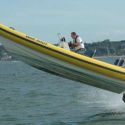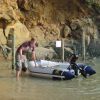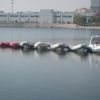 |
 02 November 2010, 13:41
02 November 2010, 13:41
|
#1
|
|
Member
Country: UK - Wales
Town: West Wales
Make: Vipermax 5.8, SR4.7
Length: 5m +
Engine: 150 Opti, F50EFi
Join Date: Sep 2005
Posts: 6,299
|
RYA, CE, ISO, structural design calculations etc
Quote:
Originally Posted by ecoXR24

...the design has now been approved by the RYA.
|
Approved for what?
__________________
|

|

|
 03 November 2010, 09:14
03 November 2010, 09:14
|
#2
|
|
Member
Country: UK - England
Town: Salcombe, Devon, UK
Boat name: BananaShark
Make: BananaShark
Length: 10m +
Engine: 2xYanmar 260 diesels
Join Date: Mar 2003
Posts: 4,225
|
Quote:
Originally Posted by ecoXR24

the design has now been approved by the RYA. A demo boat is currently being built. www.eco-marine.co.uk |
I would also like to know what you mean by this? To the best of my knowledge the RYA don't have anything to do with approving designs of any sort?
Please educate me! 
__________________
Cookee
Originally Posted by Zippy
When a boat looks that good who needs tubes!!!
|

|

|
 04 November 2010, 20:59
04 November 2010, 20:59
|
#3
|
|
Member
Country: UK - England
Town: Southampton
Boat name: SMH Rib / War Shot
Make: Ribtec / Scorpion
Length: 4m +
Engine: 100hp Yam/150hp opt
Join Date: Sep 2003
Posts: 2,069
|
RYA is a notified body for RCD
__________________
|

|

|
 05 November 2010, 10:04
05 November 2010, 10:04
|
#4
|
|
Member
Country: UK - England
Town: Salcombe, Devon, UK
Boat name: BananaShark
Make: BananaShark
Length: 10m +
Engine: 2xYanmar 260 diesels
Join Date: Mar 2003
Posts: 4,225
|
Quote:
Originally Posted by Searider

RYA is a notified body for RCD
|
OK I get that - so actually it has a CE mark - so does (should) every other leisure boat sold in Europe!
__________________
Cookee
Originally Posted by Zippy
When a boat looks that good who needs tubes!!!
|

|

|
 05 November 2010, 10:39
05 November 2010, 10:39
|
#5
|
|
Member
Country: UK - England
Town: swanwick/hamble
Boat name: stormchaser
Make: custom rib
Length: 8m +
Engine: inboard/diesel
Join Date: Aug 2007
Posts: 3,848
|
John, i think the rya had some input into the ribs that they now use but i wouldn't say it's there seal of approval as eco24 is suggesting
__________________
|

|

|
 08 November 2010, 09:13
08 November 2010, 09:13
|
#6
|
|
Member
Country: UK - England
Town: Coventry
Boat name: Eco XR24
Make: Eco-Marine
Length: 7m +
Join Date: Sep 2008
Posts: 41
|
RYA approval
Quote:
Originally Posted by Cookee

I would also like to know what you mean by this? To the best of my knowledge the RYA don't have anything to do with approving designs of any sort?
Please educate me!  |
As a Notified Body, the RYA is able to approve design calculations. We've had the RYA approve our structural design - i.e. confirm that it meets ISO 12215-5 "Hull construction - Scantlings". As most boat-builders self-certify, there is no obligation to have design calcs verified by a Notified Body. We decided to ask for it because we've optimised our structure to make it lightweight and we wanted independent verification that it meets the standard. After some minor tweaks, the RYA confirmed that it complies. We were told that ours is the first RIB hull they've done in this way. I can highly recommend them.
We will also be using the RYA to do our stability tests and I understand that it is mandatory for a Notified Body to be involved in those tests.
__________________
|

|

|
 08 November 2010, 09:30
08 November 2010, 09:30
|
#7
|
|
Member
Country: UK - England
Town: Salcombe, Devon, UK
Boat name: BananaShark
Make: BananaShark
Length: 10m +
Engine: 2xYanmar 260 diesels
Join Date: Mar 2003
Posts: 4,225
|
Quote:
Originally Posted by ecoXR24

As a Notified Body, the RYA is able to approve design calculations. We've had the RYA approve our structural design - i.e. confirm that it meets ISO 12215-5 "Hull construction - Scantlings". As most boat-builders self-certify, there is no obligation to have design calcs verified by a Notified Body. We decided to ask for it because we've optimised our structure to make it lightweight and we wanted independent verification that it meets the standard. After some minor tweaks, the RYA confirmed that it complies. We were told that ours is the first RIB hull they've done in this way. I can highly recommend them.
We will also be using the RYA to do our stability tests and I understand that it is mandatory for a Notified Body to be involved in those tests.
|
What category are you going for? Category C stability tests can be done by a suitable surveyor as can everything else.
The problem with all of the above is that they won't see every boat, and whilst I'm sure you like all other reputable manufacturers stick to the layup schedules there is no checking which makes this whole process worthless as the only time it ever comes up is if it all goes wrong. The manufacturers this happens to could care less - they will have been making transoms out of shuttering ply and saving themselves a fortune for years until it goes wrong.
I admire your dedication to "Getting it right" but our layups were still put under the microscope by a qualified surveyor but that is only maths and it means the boat is laid up on paper to a set of rules, and I would bet my colleagues 30+ years experience against a set of rules any day! It still relies on the correct procedures being followed every day.
Just one last thing - am I right in saying the RYA CE department have not actually approved the hull design but rather the structure in it?
__________________
Cookee
Originally Posted by Zippy
When a boat looks that good who needs tubes!!!
|

|

|
 09 November 2010, 08:45
09 November 2010, 08:45
|
#8
|
|
Member
Country: UK - England
Town: Coventry
Boat name: Eco XR24
Make: Eco-Marine
Length: 7m +
Join Date: Sep 2008
Posts: 41
|
RYA approval
Quote:
Originally Posted by Cookee

What category are you going for? Category C stability tests can be done by a suitable surveyor as can everything else.
I admire your dedication to "Getting it right" but our layups were still put under the microscope by a qualified surveyor but that is only maths and it means the boat is laid up on paper to a set of rules, and I would bet my colleagues 30+ years experience against a set of rules any day! It still relies on the correct procedures being followed every day.
Just one last thing - am I right in saying the RYA CE department have not actually approved the hull design but rather the structure in it?
|
Category C or B, depending on how we build the hull. Our calculations and layup schedules have been done separately for both categories and both were checked by a naval architect at the RYA. I fully agree with your comments on how the hull is built and past experience. However, in optimising a structure to make it lighter than most hulls of a similar size, we are pushing the boundaries and we wanted an independent check of our work. There is no obligation to use ISO 12215, but we've found it extremely helpful to do so. The "set of rules" it contains are actually distilled from 30+ years of experience of naval architects and boat builders, so it gives us access to more experience than we could get otherwise. Needless to say, its a lot cheaper for us to find a problem at the design stage than in a completed boat. I should add that we're aiming to sell a boat which is much more fuel efficient than average RIBs and of course we have to take a lot of weight out to do that.
The RYA has different "modules" for boatbuilders to use. We've chosen just to have our structural calcs checked, which effectively gives us type approval so long as our internal QA confirms that each hull conforms to the drawings and layup schedule. I think a B+ module includes checking the build shop and build procedures. If you need to know more, please PM me and I'll provide contact details etc. I've found the RYA very helpful.
Yes, the RYA has approved the structural design, not the hull lines. One of their modules does include static stability calcs using the hull lines, but we are going to rely on testing for this. The XR24 hull lines are well proven, but the stability criteria have changed since it first went on the market.
__________________
|

|

|
 10 November 2010, 08:26
10 November 2010, 08:26
|
#9
|
|
Member
Country: UK - England
Town: Salcombe, Devon, UK
Boat name: BananaShark
Make: BananaShark
Length: 10m +
Engine: 2xYanmar 260 diesels
Join Date: Mar 2003
Posts: 4,225
|
Quote:
Originally Posted by ecoXR24

Category C or B, depending on how we build the hull. Our calculations and layup schedules have been done separately for both categories and both were checked by a naval architect at the RYA. I fully agree with your comments on how the hull is built and past experience. However, in optimising a structure to make it lighter than most hulls of a similar size, we are pushing the boundaries and we wanted an independent check of our work. There is no obligation to use ISO 12215, but we've found it extremely helpful to do so. The "set of rules" it contains are actually distilled from 30+ years of experience of naval architects and boat builders, so it gives us access to more experience than we could get otherwise. Needless to say, its a lot cheaper for us to find a problem at the design stage than in a completed boat. I should add that we're aiming to sell a boat which is much more fuel efficient than average RIBs and of course we have to take a lot of weight out to do that.
The RYA has different "modules" for boatbuilders to use. We've chosen just to have our structural calcs checked, which effectively gives us type approval so long as our internal QA confirms that each hull conforms to the drawings and layup schedule. I think a B+ module includes checking the build shop and build procedures. If you need to know more, please PM me and I'll provide contact details etc. I've found the RYA very helpful.
Yes, the RYA has approved the structural design, not the hull lines. One of their modules does include static stability calcs using the hull lines, but we are going to rely on testing for this. The XR24 hull lines are well proven, but the stability criteria have changed since it first went on the market.
|
I am aware of the RYA's CE services and I am sure they are as good as any of the other outfits that provide this service. I think it would be a long debate if we were to discuss the validity of a fixed set of rules to build a boat by!
In my very humble opinion the concept of making a boat lighter to save fuel only really works in the real world when used in a load carrying capacity such as a dive RIB. When it gets a bit choppy lighter boats tend to take off too much which can make them uncomfortable and "flighty". We simulated this by creating extra lift on one of our race hulls which was definitely faster in flat conditions, after we removed the modifications it was noticeably faster in even a force 3.
Good luck with your new boat - I hope it exceeds your expectations and I will be keeping a look out for your fuel consumption figures!
__________________
Cookee
Originally Posted by Zippy
When a boat looks that good who needs tubes!!!
|

|

|
 |
 Posting Rules
Posting Rules
|
You may not post new threads
You may not post replies
You may not post attachments
You may not edit your posts
HTML code is Off
|
|
|
|
 Recent Discussions
Recent Discussions |
|
|
|
|
|
|
|
|
|
|
|
|
|
|
|
|
|
|
|
|
|
|
|
|
|
|
|
|
|
|
|
|
|












 War Shot
War Shot




